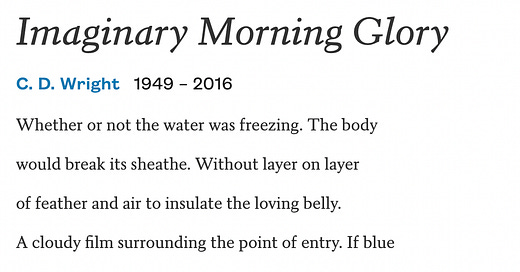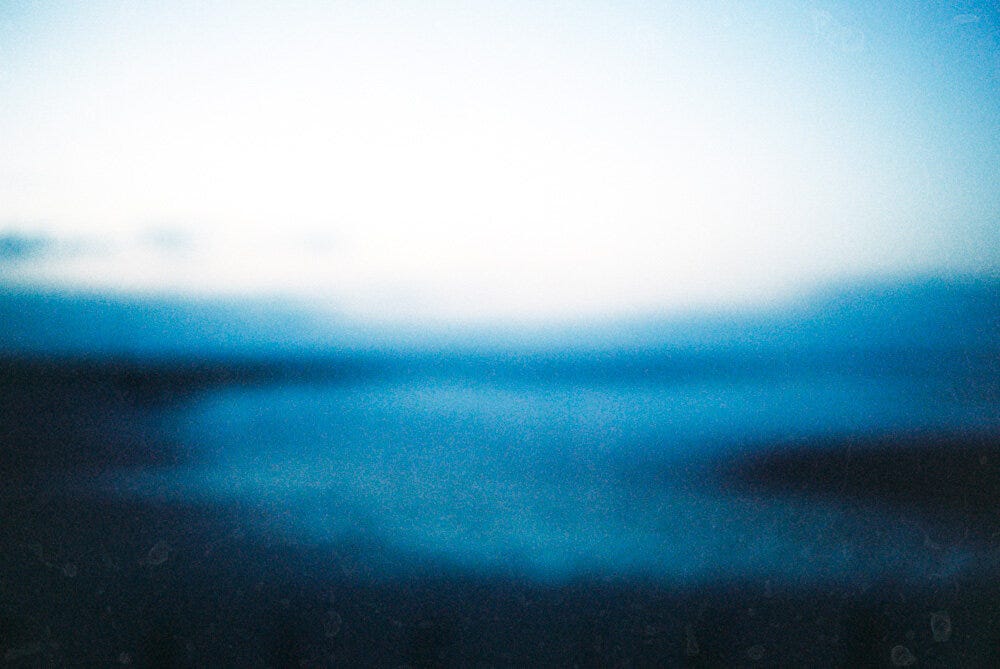From ShallCross (Copper Canyon Press, 2016)
C. D. Wright’s poetry feels diaphanous—there is no clearer descriptor. Her words catch the light, shimmer, elude, reveal, and sway. Even as her work slides between an activist body politic, the erotic, and keenly observed narrative lyricism, the same translucent and lucid quality remains: wry voice, gently probing curiosity, sense of being in conversation with the landscape (and cultural landscape) of whence she comes.
What makes a potent nature poem? I’d say: an unhurried grace, affection even, toward the natural world; an understanding of the fragility of an ecosystem and the complicated ties that bond us to one another; a heady mix of melancholy and joy; an awakeness. ‘She carries a particular Southern demographic that bears witness, that investigates history, humanity, and consciousness in powerfully innovative, often breathtaking language,’ wrote fellow poet Anne Waldman about Wright when the latter was elected a Chancellor of the Academy of American Poets in 2013. ‘Hers is a necessary poetics, on fire with life and passion for what matters.’
Yet Wright’s work, as evidenced by this poem, transcends regional specificity in its gaze. The first thing I notice is the punctuation: each phrase a clipped fragment, a crisp inhale in cold air. The exhale doesn’t occur until the poem unravels itself at the end: ‘As the petal starts to / dwindle and curl unto itself. And only then. Love, / blue. Hallucinogenic blue, love.’ I love this fluidity between colour and feeling; a transubstantiation, of sorts. When I interviewed the artist Janelle Lynch a few months ago about her recent work with cyanotype prints, she reminded me of words the late poet and theologian John O’Donohue once said: ‘Distance loves blue’. Blue is perhaps the most intimately familiar hue, and an enveloping one—sky, sea—but in its vast depths there is a spectre of distance, of faraway. Unknowability. A realm beyond the visible or corporeal.
I thought about the colour blue a lot last weekend, when I visited my old uni town of St Andrews, Scotland, for the first time in years. It’s a special place: a Mediaeval town ensconced by sea and sky and castle ruins. Its nickname is the Auld Grey Toon, a Scots reference to its stonework architecture (and, perhaps, its frequently dreich weather). But in my mind, St Andrews has always been blue. This is particularly true in the summer, when the days stretch out long and langourous; even at the dead of night, the sky this time of year never darkens beyond a gentle indigo. At dusk and dawn, the tide rolls out in a shimmering carpet, and silvery blue sky reflects on the flat expanses of West Sands beach in a beguiling mirror image. To stand ankle-deep in the water is to be surrounded by a panorama of blue. It’s quite literally awesome: simultaneously cocooning and impenetrable. I think of these lines from Scottish poet Kathleen Jamie’s ‘Fianuis,’ (the title of which means ‘testimony’ or ‘witness’ in Scots):
[…] fleet clouds and salt kiss —
everything else is provisional,
us and all our works.
I guess that’s why we like it here:
listen — a brief lull […]
I’m not sure I’ve ever felt as connected to something larger than myself than I did on the countless occasions that I used to wander down to that shore and stand there like that: the water freezing, the air brisk and windy, the North Sea beginning to awaken from slumber, my mind unfurling its many whorling gadgets and breathing its way to clearheadedness. Afterwards, I would always meander home breathless, shivering; grateful for the five minutes that the walk home afforded me to return back to my self, to my everyday life, after what felt like a tremendous journey of the spirit.
All this to say: I understand when Wright says: ‘If blue / were not blue how could love be love.’ To observe a place, to love a colour, is to love the world. To love the world is the whole, encompassing point of it all.
Until next time,
Maddy
Thank you for reading Field Guide!
One small housekeeping note before we go: you’ll note that I am also offering a paid subscription option. It’s not obligatory and you’ll receive all the same content regardless. Paid subscription will simply function as a “tip jar” to help compensate me for the time and labour that goes into researching and writing this newsletter. If you’re feeling generous and are able to do so, you can support Field Guide by upgrading to a paid subscription below. Either way, I’m grateful that you’re here.






